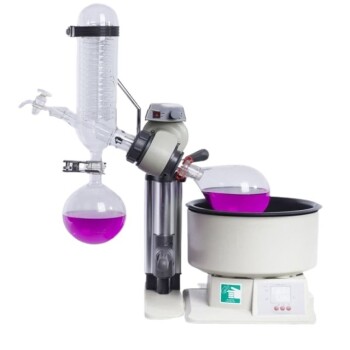Recrystallization and rotary evaporation are two distinct techniques used in chemistry, each serving different purposes and employing unique methods. Recrystallization is a purification technique where a solid compound is dissolved in a solvent and then allowed to crystallize again, leaving impurities behind. Rotary evaporation, on the other hand, is primarily used to remove solvents from a mixture, often to concentrate non-volatile components or extract volatile compounds at low temperatures. The key difference lies in their objectives: recrystallization focuses on purifying solids, while rotary evaporation is designed for solvent removal and concentration of solutions.
Key Points Explained:

-
Purpose and Objectives:
- Recrystallization: The primary goal is to purify a solid compound. This is achieved by dissolving the compound in a suitable solvent at an elevated temperature and then allowing it to cool slowly, leading to the formation of pure crystals while impurities remain in the solution.
- Rotary Evaporation: This technique is used to remove solvents from a mixture, concentrating the non-volatile components. It is also employed to gently extract volatile compounds, such as flavors and aromas, at low temperatures to prevent degradation.
-
Process and Methodology:
-
Recrystallization:
- Dissolve the impure solid in a minimum amount of hot solvent.
- Filter the hot solution to remove insoluble impurities.
- Allow the solution to cool slowly, leading to the formation of pure crystals.
- Filter the crystals and wash them with a small amount of cold solvent to remove any remaining impurities.
-
Rotary Evaporation:
- Place the mixture in a round-bottom flask.
- Rotate the flask in a water or oil bath while applying a vacuum.
- The reduced pressure lowers the boiling point of the solvent, allowing it to evaporate at a lower temperature.
- The evaporated solvent is condensed and collected, while the concentrated residue remains in the flask.
-
Recrystallization:
-
Equipment Used:
- Recrystallization: Requires basic laboratory glassware such as beakers, flasks, and filtration apparatus (e.g., Büchner funnel).
- Rotary Evaporation: Utilizes specialized equipment, including a rotary evaporator, vacuum pump, and condenser. The rotary evaporator is designed to rotate the flask, increasing the surface area for evaporation and ensuring efficient solvent removal.
-
Applications:
- Recrystallization: Commonly used in organic chemistry to purify solid compounds, especially after synthesis or extraction. It is essential for obtaining high-purity materials for further analysis or use.
- Rotary Evaporation: Widely used in chemical and pharmaceutical industries for concentrating solutions, removing solvents, and extracting volatile compounds. It is also used in food and beverage industries for flavor and aroma extraction.
-
Key Differences:
- Recrystallization focuses on the purification of solids by dissolving and then crystallizing them, leaving impurities behind.
- Rotary Evaporation is designed for solvent removal and concentration of solutions, often used to isolate non-volatile components or extract volatile compounds at low temperatures.
In summary, while both techniques are essential in chemistry, they serve different purposes and are used in different contexts. Recrystallization is a purification method for solids, whereas rotary evaporation is a concentration and extraction technique for solutions. Understanding these differences is crucial for selecting the appropriate method based on the desired outcome.
Summary Table:
| Aspect | Recrystallization | Rotary Evaporation |
|---|---|---|
| Purpose | Purification of solid compounds | Solvent removal and concentration of solutions |
| Process | Dissolve, filter, cool, and crystallize | Rotate flask, apply vacuum, evaporate solvent |
| Equipment | Beakers, flasks, filtration apparatus | Rotary evaporator, vacuum pump, condenser |
| Applications | Organic chemistry, solid purification | Chemical, pharmaceutical, food, and beverage industries |
Need help choosing the right technique for your lab? Contact our experts today for personalized advice!











